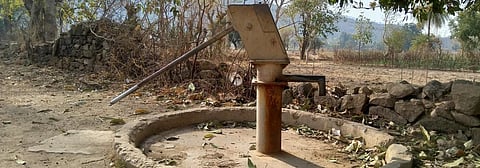

Groundwater levels reportedly have dipped in 11 of Bihar's 38 districts despite a good monsoon in 2019. The state is predominantly dependent on agriculture.
In Katihar the level dipped to 25 feet, according to a telemetry report released by the Bihar’s minor water resources department in February, 2020. Several rivers, including the Ganga, Mahananda, Kosi and Righa, pass through the east Bihar district. The level dropped to 24 feet in Begusarai and 21 feet in Gaya.
In Gaya, Aurangabad, Rohtas and Patna districts, the levels were measured at 21 feet, 19 feet, 18 feet and 17 feet respectively. In Jamui and Buxar districts, the levels were recorded at 14 feet and 13 feet respectively; in Arwal and Bhagalpur the levels were at 10 feet.
The state received monsoon rains 3 per cent above normal, according to an October 2019 report by SANDRP, an informal network of organisations and individuals working on issues related to water security.
“Groundwater table has indeed dipped alarmingly in some districts compared to the past two years. The state government has launched various measures to re-charge ground water,” said the state's Minor Water Resources Department Secretary Kumar Arun Prakash.
The government was removing encroachments from near water bodies, renovating thousands of tanks, canals and traditional water sources, he said. It also planned to clean 3,000 ponds, renovate 8,387 wells, 1,600 ahar-pynes, construct 6,000 soak pits and check 2,000 dams on small rivers by 2022. It will spend Rs 24,524 crore on the measures under its much-publicised Jal-Jivan Hariyali programme.
Residents had encroached in around 34,559 water bodies in Bihar, of which permanent encroachments from 2,123 water bodies were removed, according to a December 2019 survey.
Environment activists and experts said the government needed to do more to tackle the issue. They cited several reasons for rapidly-depleting groundwater.
“One of the main reasons behind this situation is that the general masses as well as farmers are slowly getting heavily dependent on groundwater for potable water to irrigation purposes. They are over-exploiting groundwater,” said water conservation expert Kishore Jaiswal, adding that farmers turned to submersible pumps to drain out more water.
“Farmers also still depend on flood irrigation instead of using drip irrigation or sprinklers,” he said while also pointing out a fast-disappearing forest cover.
“Instead of preserving surface water and depending on traditional methods for irrigation, famers are drilling holes in the surface to take out water. As such, they find groundwater as the only source of water left for them and that is worsening the situation day by day,” said Ranjeev Kumar, an activist working on saving water bodies and rivers.
Kumar said schemes like System of Rice Intensification (SRI), a paddy cultivation method that needs relatively less water, were good, but the government needed to train farmers. “People’s participation in such campaign is a must for success,” he said.